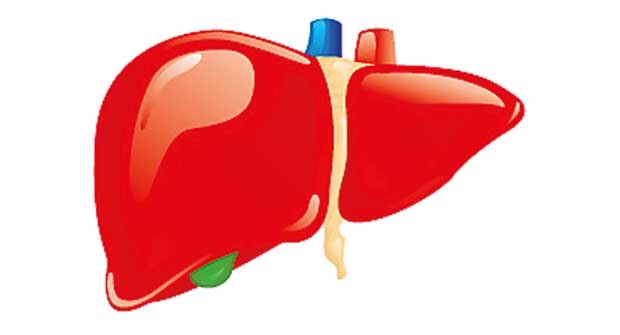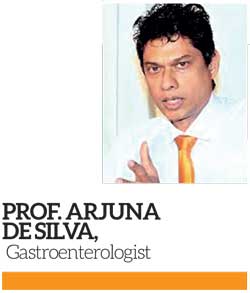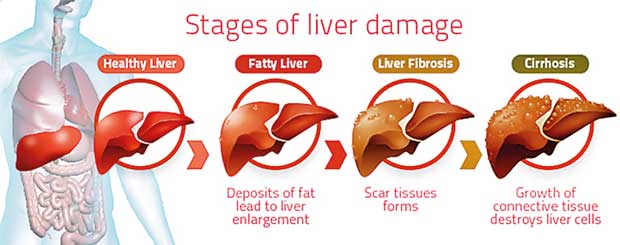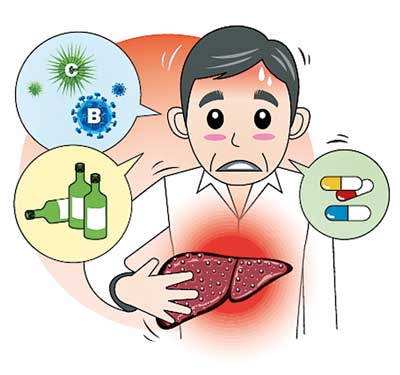Reply To:
Name - Reply Comment

By Janani Angammana 
Cirrhosis is a complication of the liver which develops when scar tissue replaces the normal, healthy tissue in your liver. This takes place when healthy cells are damaged over a long period of time, usually after many years. These scar tissues cause the liver to become hard and lumpy and may lead to liver failure. It also makes it difficult for blood to flow through the large vein that leads to the liver. Due to this, the blood will back up into the portal vein and may enter the spleen, causing complications in that organ as well. The only cure for cirrhosis is a kidney transplant; but one can also consult a doctor and slow down cirrhosis by treating its cause. Health Capsule spoke to Professor Arjuna De Silva, a Gastroenterologist, on how cirrhosis can be dealt with. “Cirrhosis is considered to be present when 75% of the liver is damaged. In the past, we thought cirrhosis was not reversible but now we have found that it is. At the moment if you want to cure cirrhosis, a liver transplant must be done. Usually in Sri Lanka, the main cause of cirrhosis is due to alcoholism and a fatty liver. Women are more prone to fatty liver than men. The annual mortality rate per 100,000 people from cirrhosis in Sri Lanka has increased by 110.0% since 1990, an average of 4.8% a year.
Cirrhosis can be caused due to: Alcohol-related liver disease
Alcohol addiction is a risk factor for cirrhosis. It causes inflammation and fatty deposits in the liver. The consumption pattern of alcohol should be different for men and women. Women shouldn’t have more than one drink and men shouldn’t have more than two drinks per day.

Viral hepatitis
Hepatitis is the inflammation of the liver. It can be caused by the heavy use of alcohol, certain medical conditions and some medications and is most often caused by viruses. Hepatitis C is the most common variety in the United States. You can get either of these by coming into contact with infected blood. This might happen if you:
Hepatitis D also can cause cirrhosis.
Non-alcoholic fatty liver disease
Even if a person is not addicted to alcohol, there is still a risk of fat building up in the liver. There are certain reasons for extra fat to be present in the liver:
Autoimmune hepatitis
In some people, the body defences (immune system) go haywire, attacking the liver. According to doctors, it is probably genetic. Autoimmune is more common in women than in men.
Bile duct disease or damage
These ‘bile ducts’ are small tubes that carry bile from the liver to the small intestine. Cirrhosis is caused in these bile ducts as a result of the ducts being blocked because of an injury or disease and the bile backs up into the liver. The two conditions that can lead to bile duct damage are gallstones and cystic fibrosis.
Medications
Some drugs can cause cirrhosis if taken for a long time.
There are two types of cirrhosis, namely ‘Compensated’ and ‘Decompensated’.
In compensated cirrhosis, there are no symptoms. There are still enough healthy liver cells to meet the body’s needs. They compensate for the damaged cells and scared tissue. If the treatments are delayed, the liver will not be able to get rid of toxic substances in the body, like ammonia.
Decompensated cirrhosis causes symptoms like:
Individuals with cirrhosis may have some or no symptoms of liver disease. Some of these symptoms may be non-specific that is, they don’t suggest that the liver is the cause. Some of the more common symptoms and signs of cirrhosis include:
Diagnosis 
Several tests are used to confirm the diagnosis of cirrhosis and to determine the underlying cause. Other tests are useful for determining the severity of cirrhosis and for monitoring complications.
Liver biopsy
Obtaining a small piece of tissue from the liver with a special needle during liver biopsy can be done as prescribed by your doctor.
Imaging tests
A variety of imaging tests such as an ultrasound scan, CT scan or MRI can show whether a person has cirrhosis or not. These tests can describe the appearance of the liver and identify if there are any related complications.
Physical examination
The physical signs of the condition will include one or more of the following:
Laboratory tests
This can often reveal the specific underlying cause of cirrhosis. These tests can be seen in people with early cirrhosis.